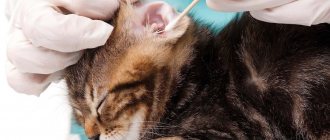Cats are quite capricious, freedom-loving, independent animals. Each individual, even within the same breed, has its own disposition, temperament, habits, and character. Some mustaches constantly require the attention of their owners and literally do not get off the laps or hands of their beloved owner, others are reluctant to make contact with a person and allow themselves to be stroked and cuddled only when they have the desire and the mood. How to raise an affectionate, easy-going pet? How to accustom a kitten to being held? You will learn the answers to these questions from this article.
Tame your kitten to sit in your arms from childhood
The easiest way to accustom a kitten to yourself is from childhood, namely up to 8 months.
Tame your Briton from childhood.
You can hand feed him and then put the treat on your lap. Fascinated by food, he will definitely jump after it, and while he is eating, you need to gently pet him. Soon your hands will begin to evoke positive emotions in the kitten.
Little kittens are terrified of heights, so it's best to pick up your baby while you're sitting. You need to hold the kitten carefully, without holding it by the body near the ribs and withers. This may hurt him . You need to hold him by the armpits with one hand, and support his hind legs with the other. This way he will feel balanced and the fear of heights will disappear. If the kitten feels calm, the problem will be solved.
Owner's robe and scent
The cat is used to the smell, and remembers it among the smells of the street on winter clothes
Many people advise purchasing a soft terry robe and placing the baby in its pocket. He will get used to it, begin to consider it his property and may even want to sleep with it. And your smell will become dear and beloved to him and will remain in his memory for many years.
How to accustom a kitten to a name: ways
To get the fastest and most guaranteed results, you can use various techniques and strategies to accustom your cat to a name.
With food
You can build learning based on scientific facts and theories. For example, based on Pavlov's experience. Surely every schoolchild remembers the experiments this scientist performed on a dog. Its essence is to develop an unconditional reflex to the desired stimulus. In this case it is the name. The easiest way is to accustom the kitten to its name while eating. To achieve the desired result, it is necessary to prepare the food in advance. In order for the kitten to get used to responding to its name and not stomping into the kitchen in response to the opening of the refrigerator.
When the food is ready, you need to call your pet using a familiar sound. For example "ks-ks". This sound is then combined with the name. In this case, you need to point your finger at the bowl. While the kitten is there, you need to affectionately call him by name and stroke him.
Cat eats cake
You can also use treats to train your cat. The treat is used at the moment when the cat has done what they wanted to train it to do. For example, I responded to a name. To use this method, you need to know what treat your pet will be interested in and always carry it with you: in your robe or trouser pocket. When the kitten does what is asked of him, he gets a treat.
To ensure that the kitten does not get confused, all family members should call it the same. Variety can be added later, when the kitten gets used to it and remembers its name. When he appears in sight, you need to take out a tasty treat and call him by name. Thus, over time, the animal will get used to it and begin to associate the name first with the treat, and then with the owner.
Recommended reading:
The average lifespan of cats and how to extend it
Cat eats cake
Through games
When the kitten gradually gets used to its name, you can consolidate the result with the help of a game. Each time you play, you need to say the name of the animal. You can also use a bow on a string for the game and call your pet by name only when he catches the bow. The nickname should be pronounced in a gentle and calm voice. If the kitten experiences negative emotions while learning its name, it will be more difficult to continue the process.
kitten playing
When the kitten gets used to the name, you can complicate the task. For example, calling him from the next room, if he comes to the call, you need a reward. You can call your baby from different rooms, the main thing is not to forget about his unconditional motivation to respond to his nickname.
With the help of caresses
Weasel is a universal language used by all creatures with communication skills. For a small kitten, recently in the caring arms of its mother, affection is very important. She allows him to feel safe and remember his very first pleasant memories.
Photo of a purring cat
When petting, you must call the pet's name, then it will be associated with the owner, safety and tenderness. If the conditioned reflex to a treat can go away over time, especially if there is no nourishment, then the reaction to tenderness and affection will always be the same.
We teach a British cat affection step by step
British from hand sitting
You need to accustom an adult animal to affection gradually and little by little. At first, you can gently and carefully scratch your Briton behind the ear (many cats are delighted with this) or stroke it, and this should be done only in the direction of growth of the pet’s fur. But under no circumstances grab him or squeeze him . If the cat begins to nervously beat its tail and show irritability, immediately leave it alone.
It is better to show affection when the cat has just woken up or goes to bed. Every day there should be more “portions of love”.
Sleep and the hands of the owner
Be sure to encourage any gentle impulses your pet makes in your direction; you can let him sleep with you. If the cat sleeps separately, carefully pick him up while he sleeps. It is quite possible that lying on them, he will continue his sleep.
When you feel that he is already accustomed to stroking, you can try to take your pet in your arms . If the cat starts to struggle, you should not hold him by force. This may frighten or anger the Briton, and it will be very difficult to win his favor again.
Source
Character
The Scottish cat has a slightly playful character, kindness and calmness. This breed becomes strongly attached to its owner and is good friends with other pets and small children. The main advantage of the Scottish cat is silence; they rarely meow and are very quiet.
This breed will be ideal for a person who leads a quiet life without fuss. Small lop-eared kittens may behave badly as children, but do not cause damage to the home. Animals love to hide various small objects. These cats love cleanliness very much, they are quite smart.
Adult cats are affectionate, calm and understand everything well. They know how to obey if it is in their interests. They can be stubborn if they don't want to do something. This breed loves to be friends with people; cats choose their leader and are constantly with him. Animals are very loyal, but never impose themselves. They love to lie near their owner, but not in a person's arms.
The Scottish Fold cat loves to meditate and stretches its paws forward. A pet of this breed prefers to sleep on its back and loves massage treatments performed with special combs. The cat has a gentle and soft character, so it will become a good friend for every person.
Most owners say that this breed is considered an ideal pet, as it does not harm and is well-bred. Externally, cats are cute, beautiful and gentle, they will not leave anyone indifferent. The character of the Scottish cat itself is good and harmless.
How to make a British cat affectionate: secrets of proper upbringing
When the fluffy plush ball crosses the threshold of the house, the whole family is delighted: “So tender, so kissable, I really want to cuddle!” And somehow I don’t think at all about how to make a cat affectionate, sociable, playful. Getting used to the litter box, to trimming nails, to bathing - yes, these are important tasks. And the weasel? Yes, of course she will grow up affectionate, we love her so much! Why does a cat suddenly become capricious and angry?
However, developing a preferred character in a pet is a more difficult task than raising a child. The cat does not understand or does not fully understand the meaning of the words, does not feel guilty and acts based on previous experience. For a cat to become very affectionate, care and love alone are not enough, although we like to think otherwise. It is important to understand the psychology of these animals and realize that lost time is the biggest problem. If there is a little five-year-old monster living at home, even in six months it will not be possible to turn him into a gentle princess - cats are stubborn and conservative to the extreme.
However, with due patience and free time, even a wayward aggressive cat can be taught affection and trust.
By the way, without absolute trust in the family, all efforts will be in vain: constant vigilance will not allow the pet to relax, and the cat will never become affectionate. So, seven secrets of raising and keeping a small predator:
Coat color
A purebred cat has many coat colors.
There is no such diversity of color among all known breeds around the world. This is due to the fact that various breeds were mixed. Also, a purebred cat is characterized by a varied character and appearance. Very often, a cat that lives in the north is massive and has fluffy fur. The cat on the south side is distinguished by its elegance and grace. It has a fine coat and a small undercoat. These are the influences of climate and area of residence. Among cats, there are very often those that have striped colors. With different patterns and spots. You can also find a cat that has three suits together. People also call them happy. The most common color is striped. It helps to camouflage the animal. Helps when hunting birds, rats, mice. A great rarity among these animals is the white cat. There are some countries on the planet that have cats with blue fur. This color developed independently, humanity has nothing to do with it.
Very often such kittens without a breed can be found on the street. Or borrow from friends and relatives. In most cases, if you pick up a kitten on the street, it will be a devoted friend for the rest of its life.
Cats that do not have a breed are characterized by good health. There are no specific diseases such as in purebred animals of this genus. But, if an animal has lived outside for a certain time, it can also get sick.
A mongrel cat that lived on the street is very hardy and resilient. And also has his own ingenuity. Because life on the street is not easy, and without the listed qualities the animal would not survive in such conditions. This hardened them.
I eat it myself, I won’t give it to anyone!
A very affectionate cat is a contented cat. And what kind of satisfaction can we talk about when people interfere in such an intimate process as eating? Remember how cats eat in nature - alone, away from everyone, in a secluded place. The beloved should eat in a calm environment, on an elevated platform, without the accompaniment of an orchestra of rattling pans. The cat does not understand that the child screaming nearby is not at all encroaching on her lunch. Eating in constant tension, hastily, swallowing huge pieces, the cat experiences stress.
Tenderness on schedule
Remember that this is not a battery-powered toy, but a living creature. Only a few pets are willing to wait forever until the owner has time to communicate. A very affectionate cat is a caressed cat with whom they “talk”, hug, watch TV together and relax together reading the newspaper. But there is so much work and other important things to do... As they say, let the whole world wait, ten minutes of respite will not hurt anyone.
You can’t get a kitten when you have little time left to communicate with it. The kitten will grow up quickly, and he will grow up unsociable, not tame and not affectionate. Even adult animals, which were temporarily forgotten, are gradually becoming wild. And the baby, growing up alone, will close himself off from people with a thick wall of mistrust.
However, you should not impose. Cats, like people, can have different moods. Even an overly affectionate cat sometimes wants to take a peaceful nap on the windowsill or just sit in deep thought on important cat topics. As you pass by, scratch the beauty behind the ear - fleetingly, without pressure. She answered with a purr - we can “talk” a little.
Didn't you deign to purr? Well, okay, we'll talk later. Many owners are surprised why their cat is not affectionate: “We pet her all day, scratch her, hug her, there is always someone at home and we always make contact, but she just doesn’t want to purr and be caressed.” Where exactly! I wouldn’t howl like a dog at such a blatant violation of the intimate area!
Spray bait
Sometimes a cat must be accustomed to being handled using a special bait spray, which is sold in a pharmacy and usually contains catnip extract; this is necessary in cases where the kitten has been running wild for a long time and categorically refuses to make contact. Most often, this phenomenon is observed if the animal has suffered from people and because of this cannot help but fear even its owner, who loves it and has created comfortable living conditions for it. Also, basement kittens, which have largely returned to the behavior of their wild ancestors, are often distinguished by distrust.
The spray should be applied not to clothes, but to the palms of the hands, so that the kitten gets used to the person, and not to the thing. The smell of the product acts on the animal like a drug, and therefore the pet will, despite its fear, still run to the owner and rub against the hands. Gradually, the kitten will understand that there is nothing dangerous or unpleasant when communicating with a person. As a result of this, in the future, even without a spray, the pet will be willing to be handled.
When using a spray, it is important not to exceed the norm so that the baby does not become accustomed to it and begins to suffer from the lack of the drug. Because of this, you cannot use the product more often than once a day. This remedy should be used more often if you had to take an adult cat into your home.
A tame animal?
When people decide to get a kitten for the first time and contact a cattery, they ask breeders the same questions. One of these questions is: “Show me how to properly pick up a baby?” And they are surprised when they hear in response: “Why pick him up?” This point is unclear to many owners, but for a cat to become very affectionate, you don’t need to constantly carry it in your arms. Cats are independent and perceive any restriction of movement as a danger. Will a kitten be affectionate, being in a state of fear all the first days in a new home?
But I want to! He's so cute! Place the baby on your lap, without holding him by force, and be as gentle as you like. How to trim claws? Sitting next to a cat, there is no need to grab and wring your pet, as if you were a fascist caught in the Russian forests. Should I put him in the bath? Place your palm under the chest and carefully lift it, stroking the back with your free hand. The cat must feel that it can leave at any moment, only then will it trust the person.
High relationship
Think about how to raise an affectionate cat if your pet constantly feels tension, stress and anxiety? Of course not. A contact trusting cat is a cat that feels safe. What do small cats do when threatened? Of course, they climb the nearest tree. It just so happens that in nature cats have almost no enemies capable of catching up with the agile steeplejack. Therefore, it is extremely important that the cat has a lot of shelters at height: playing complexes in the ceiling, “trees” for climbing, hanging houses, shelves and ladders.
Toys or games?
Manufacturers of pet products regularly replenish the range of toys with a variety of options for “prey” for domestic predators: wind-up mice, on a string, on a spring, glowing balls, fragrant fish and fishing rods... But to raise a cat to be affectionate and sociable, it is not enough to spend a certain amount on new items from the store . Games must be joint, regular, within the family circle. By playing together, a person and a cat learn to understand each other, trust each other and, ultimately, certainly become closer.
Never use your hands or feet to try to get your cat's attention. Don't tease her by scratching your fingers along the upholstery of the sofa. Human legs and arms are an absolute taboo. Explain to everyone at home that scratched skin and torn clothes are not your dream. If a kitten attacks in the heat of play, grabbing the skin with its teeth or claws, do not pull your hand away. Freeze, look closely at the bully and hiss threateningly - he will let you go.
Training kittens to use a scratching post
To ensure that the apartment does not lose its original appearance after the appearance of a four-legged friend in it, the cat should be taught to sharpen its claws in certain places from a very early age.
A three-month-old kitten is already beginning to scratch surfaces with its claws. Depending on the breed, the cat may start doing this either later or earlier. Of course, most owners, almost immediately after the furry appears in the house, buy him, in addition to toys, a scratching post
But a cat's character is unpredictable, and the kitten may not pay attention to a useful gift
You need to start accustoming your kitten to a scratching post from a very early age.
In this case, they resort to involving the pet in the device. As a rule, in cases where the kitten’s training does not occur immediately, the process takes a month or a little more. With the right and attentive approach, the animal quickly gets used to the nail clipper.
Kittens and cats are taught to use scratching posts:
- smells;
- frequent play with a new object;
- praise and treats;
- observation.
Attracted by smell
One of the most favorite cat scents is the scent of valerian. Apply a little valerian to the device. Few cats can resist the pull of this smell. Gradually, the cat will begin to sharpen its claws exclusively on it.
Games
Play is one of the most effective ways to attract an animal to a scratching machine. They play with the kitten, involving a scratching post in the process. For successful training, various toys with tails are used. The tail of the toy is drawn along the surface of the device, and the kitten imperceptibly begins to play with the claw clipper. This way you can quickly accustom your baby to the scratching post.
Note! Play is extremely important for a kitten. He needs to move
Jumping, running, playing hide and seek, especially at night, may not appeal to those who come home from work tired. But if you give your pet time and play with him for a long time in the evening, then nighttime hyperactivity can be avoided.
Affection and delicacy
You need to praise the kitten as often as possible for “communicating” with the scratching post. All animals love praise and affection. This way the kitten will understand that he is being rewarded for certain actions. The best type of reward is a treat.
If the cat does not sharpen its claws on a special board or post after all the described actions, it is necessary to check the device for an unpleasant odor and the quality of the rope or fabric. It is possible that the animal did not like the material of the product. In this case, you will have to think about purchasing another model.
Observation
Cats sharpen their claws in different ways. Some prefer vertical surfaces, others tear up carpets and floors. The easiest way to choose the right device is to observe your four-legged friend.
For some time they observe which surfaces the cat prefers. Based on his habit, they purchase a claw tool.
Various toys provide invaluable assistance in training a child to use a scratching post. You can independently attach the toy to a post or board using a rope.
Important! The toy must be secured so that the kitten cannot get tangled in the lace or rope. The baby needs to be supervised during games
Hooray? Victory?
Goodbye scratched hands! Now my beast will surely become the most affectionate cat! We hasten to disappoint: failure to fulfill at least one of the conditions can lead to open aggression, but strict adherence to all recommendations does not guarantee a sociable character. The fact is that all the advice on the topic “How to make a cat affectionate” does not work in a number of cases:
✅ if the kitten inherited a quarrelsome character, that is, there is a “harmfulness gene”, you will have to put up with some inconveniences. Hereditary aggression does not recede in the face of proper upbringing, but only subsides a little. This is why breeders remove all cats with mental disorders from breeding;
✅ if a kitten is born in a basement, and its mother is a semi-wild cat, hissing at all passers-by and attacking anyone who dares to reach out to the kittens, the baby’s character will never become absolutely gullible. Wildness is an explosive mixture of genetics and early experience, and it is very, very difficult to cope with;
✅ debates on the topic “Who is more affectionate, a cat or a cat?” will continue forever. And all because the character of a pet depends little on gender. An affectionate cat is a cat who is completely satisfied with life. And so that all efforts do not go in vain, it is important to remember that the pet’s health comes first. When feeling unwell, not a single cat will be happy with a new toy, will not be able to truly enjoy a delicious dinner, or will trustfully relax under a person’s hand.
If your cat is aggressive for no apparent reason, be sure to take her to the vet. Perhaps this is due to a chronic illness that exhausts the pet physically and emotionally. By the way, if an unsociable cat suddenly becomes too affectionate, a visit to the doctor is also necessary - such changes can signal hormonal problems and other ailments.
Patience, attention to detail and the awareness that a cat has its own passions and interests will definitely help you raise a cozy pet from a small predator. Study the life of cats in nature - this greatly helps to understand the behavior of your pet in a given situation.
Source
Health
Scottish cats have a genetic predisposition to various diseases. This may not occur in all animals, but it is important to be aware of what problems a future owner may face. Thus, fold-eared cats are predisposed to diseases that are associated with the skeleton. Osteochondrodysplasia, which is inherited, is not excluded. This disease causes skeletal deformation, impaired movement and problems with the tail. The disease can develop in both a kitten and an adult.
The following signs of pathology are observed:
- lameness;
- stiff gait;
- avoidance of jumping;
- touching the cat's tail hurts;
- the animal walks squat.
If such a disease develops, it is forbidden to allow the animal to be mated. When breeding with a sick pet, there is a high probability that kittens will be born with problems with the motor system.
Scottish cats are prone to heart disease. If you get vaccinated and visit your doctor regularly, preventive measures can improve your pet's life. On average, this breed lives from 10 to 15 years.











